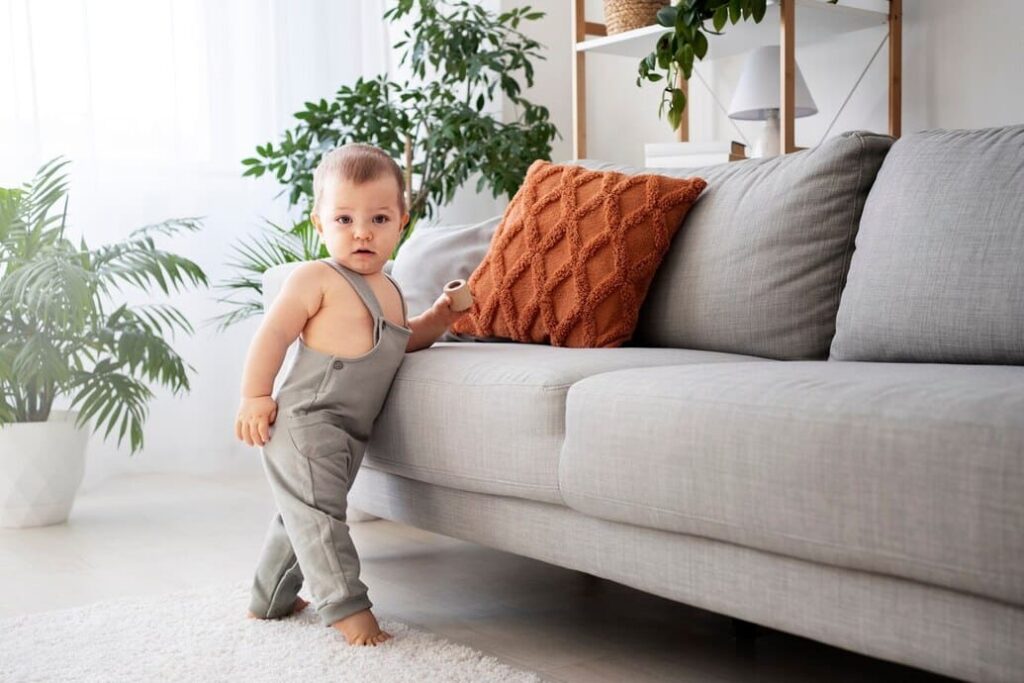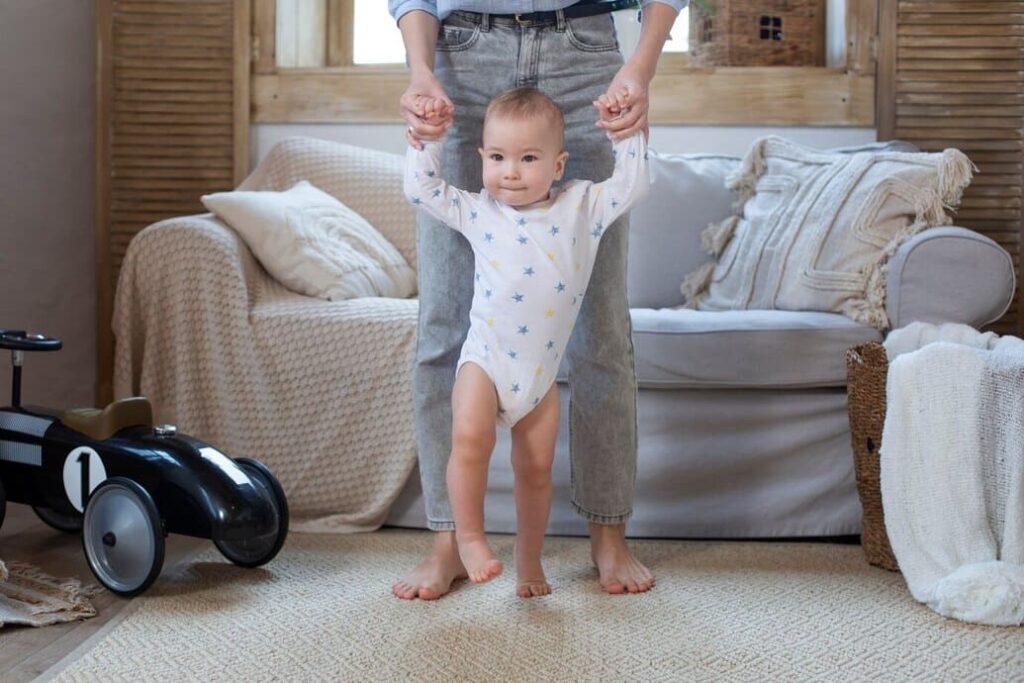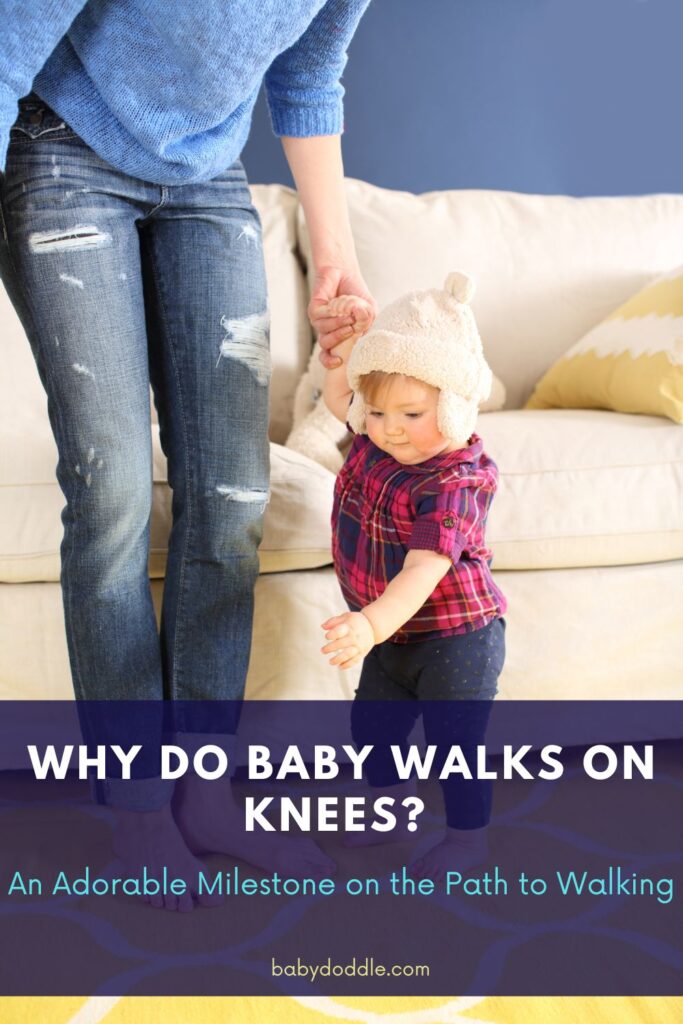As a parent, watching your baby hit developmental milestones can be incredibly exciting. From coos and smiles to first crawls and steps, each new achievement fills your heart with pride and joy. However, you may find yourself puzzled when your baby walks on knees or opts to scoot around on their knees instead of properly crawling on all fours. While unusual, this cute knee walking phenomenon is actually quite common.
Knee walking serves as a natural transition stage between crawling and walking upright. This temporary knee walking habit helps little ones build leg strength and balance closer to the ground before officially taking off on their own two feet. Read on to better understand why baby walks on knees and how to ensure safe passage through this adorable stage.

Development Milestone Ages Across Cultures
Child development researchers once believed that western milestones represented universal markers of growth for all babies regardless of culture. However, fascinating real-world data reveals walking timelines differ greatly across continents.
Studies show babies from African and Caribbean ethnic backgrounds consistently walk earlier, with average ages between 9 and 11 months. Researchers theorize increased infant carrying in wraps or back slings enables more active leg muscle development. Anglo-European babies average 12-13 months for those first solo steps.
In many Asian cultures, passive equipment like walkers, bouncers and container seats prevail over floor playtime. Correspondingly, average walking ages are the latest globally, hitting 13-15 months on average. Pediatricians urge ditching restrictive gear for more “tummy time” and other active chances to build motor skills.
What’s Normal for Baby Development?
To better grasp the role of knee walking, it helps to understand typical milestones along the path to walking:
- 3-6 months: Rolling front to back and back to front
- 6-10 months: Sitting independently, scooting/army crawling
- 8-13 months: Crawling on hands and knees
- 9-16 months: Cruising (walking while holding onto furniture)
- 10-18 months: First independent steps
As you can see, there’s quite a bit of variability in the timeline. Every child progresses at their own pace when building the necessary muscle strength, balance, and coordination. Knee walking simply slots in wherever needed as they work towards upright walking.
Fun Facts & Trivia About Baby Walking Milestones
Did you know the earliest recorded age for independent walking is a remarkable 4 months old? On the flip side, some babies take their first solo steps as late as 20 months and turn out perfectly fine. Every child progresses at their own pace.
The average age for walking is between 9 and 15 months according to most pediatric development charts. However, a 2021 Norwegian study found the mean age has increased to 12.9 months over recent decades. Researchers theorize increased use of baby gear like walkers, jumpers and container seats has actually delayed some mobility milestones compared to past generations.
Fascinatingly, cultural differences demonstrate significant influences too. A 1990 study found babies from African ethnic backgrounds consistently walk earlier, with mean ages of 11 months versus 13 months for American and European babies. Researchers believe increased “baby wearing” in slings provides more opportunity to build leg strength compared to container seats.
When Can You Expect Independent Walking?
While babies take those first tentative steps anywhere from 10-18 months, the average age is around 12 months. If your baby is not walking independently by 18 months, consult your pediatrician to discuss a developmental assessment.
Factors impacting the timing including your baby’s:
- Overall muscle tone
- Leg and foot strength
- Innate drive for independence
- Confidence and personality
You play a key role too through encouragement, stability aids like push walkers, and ensuring plenty of safe floor playtime for practice. Stay patient and let your baby set the pace.
Preparing Your Home For A Cruising Baby
Well before those first tentative steps, take time to thoroughly baby proof any spaces your infant will occupy. Install safety gates at the top and bottom of stairs, anchor furniture to walls, secure loose rugs and hide loose cords your cruiser could grab.
Pay special attention to open kitchens or media cabinets where curious hands could get into mischief once newfound mobility takes off. Corner guards, cabinet locks and padded furniture edges are a must. Consider adding baby monitors or visual barriers around high-risk areas if you can’t fully block access.
Keep pathways clear of clutter and small objects. Beware lightweight items that could topple if pulled upon. Non slip pads under rugs provide affordable insurance against slips or tumbles during all that excited practice.
Celebrating & Encouraging Each Achievement
Each tiny triumph deserves fanfare on your baby’s exciting road to walking. Consider hosting a family celebration when your little nugget first successfully army crawls, pushes up onto hands and knees or takes those early cruising steps along furniture. Capture the magic in photos and video to look back on.
You can also try incentives like milestone growth charts, sticker rewards or clap-activated dancing toy robots to motivate your baby towards the next goal. New toys that fascinate curious minds like activity tables with buttons or busy box baby gyms make fantastic crawling and walking incentives too. Experts recommend pull-behind toys to encourage practice once early steps emerge.
Why Do Babies Opt for Knee Walking?
Babies generally cruise around on their knees for a few key reasons:
Lower Center of Gravity
Walking upright requires constantly shifting weight from side to side while maintaining balance. This can feel precarious for babies still developing core stability. Dropping to their knees lowers their center of gravity for better control.
Muscle Development
Cruising around on their knees builds critical strength in their hips, legs and feet while allowing their top half to rest on hands or forearms. By bearing weight through new leg muscles, little ones progressively prepare for the demands of upright walking.
| Milestone | Average Age Range |
|---|---|
| Rolls over | 3-6 months |
| Sits independently | 6-9 months |
| Crawls on all fours | 8-13 months |
| Cruises along furniture | 9-16 months |
| Stands unassisted | 9-12 months |
| First solo steps | 10-18 months |
Injury Prevention
The amount of sheer activity in a baby on the brink of walking is impressive. Crawling on knees reduces strain on tender wrists, knees and feet compared to crawling on all fours at top speed! This may help prevent issues like carpal tunnel or Osgood-Schlatter disease as your child ages.
Now that you understand why babies choose this route, let’s explore the developmental benefits knee walking offers.
Astonishing Benefits of Baby Walks on Knees
While unusual, this temporary pedestrian preference packs some surprising perks:
- Muscle and Bone Development
Propelling themselves forward builds muscle, and the slight impact stimulates bone density in their hips, legs and feet. Knee walking provides the perfect gentle resistance for growth.
- Balance, Stability and Motor Skills
The coordinated movements required to crawl on knees bolster balance, strength and overall motor control – skills that translate directly into confident walking abilities.
- Brain Boost
The cross lateral pattern of opposite arm and leg advancing at the same time is linked to cognitive gains. Lifting left knee and right arm simultaneously fires neurons and forges neural connections.
Now that you know all the benefits of this stage, you can breathe easy seeing your baby strengthened while having fun scooting around. But what if they seem stuck on knee walking longer than expected?

Troubleshooting Uneven Development Stages
Parenting message boards frequently erupt with confusion when a formerly smooth trajectory goes off the rails. Your baby may crawl with gusto one week then resort back to scooting the next. Or they may walk independently for 2 whole days before needing handholding once more.
Remember – skills backslide as babies encounter growth spurts, illnesses or simply need to consolidate strength before attempting new feats like standing alone. View setbacks as an opportunity to revisit foundational stepping stones with extra practice. Celebrate re-achievements as you would any other developmental win!
If you notice abrupt losses lasting over 2 weeks or inability to perform skills once mastered, do seek medical advice. But typically uneven progress rights itself if you offer encouragement through each wobbly stage.
Common Causes and Safety Concerns with Prolonged Knee Walking
While most toddlers pass through a short knee walking phase without issue, extended duration or accompanying developmental delays may warrant a closer look. Two key underlying causes include:
Retained Infant Reflexes
Babies enter the world with primitive reflexes that soon integrate or fade to allow intentional movement. One called the asymmetric tonic neck reflex causes babies to assume the crawl position when the neck turns to one side.
If retained past 6 months, these involuntary motions Override voluntary efforts, preventing development of skills like crawling, standing or walking. See your pediatrician if you notice arching, odd movements or difficulty transitioning positions.
Underlying Orthopedic Issues
Bone or joint conditions like hip dysplasia, blount disease or genetic disorders can make walking uncomfortable or challenging. Trouble standing or play disrupted by irritability or limping may indicate a need for medical intervention. Prompt pediatric orthopedic care can often resolve the problem, allowing normal development to resume.
While worrying, knee walking itself is rarely dangerous. Still take basic safety precautions like limiting stairs access, using knee pads if needed and ensuring adult supervision since little ones on the move explore quickly!
If you have any concerns on development, injury prevention or encouraging mobility, don’t hesitate to ask your pediatrician.
| Milestone | Tips to Practice Skill |
|---|---|
| Rolling | Tummy time play, rotate toys to reach |
| Sitting | Support at adult hands in sitting position, use boppy pillow |
| Crawling | Place toys just out of reach, crawl/race with siblings |
| Cruising | Clear paths along furniture, use toddle walkers |
| Standing | Play “airplane” lift game with adult hands, use activity centers |
| Walking | “Train” walking with siblings in line, use pull toys |
Preparing Older Siblings for Baby Mobility
The chaos created by a cruising baby overwhelms many first-born children accustomed to calm. Transform older siblings into your helpful baby safety squad before the nonstop movement begins! Convince them pokier milestones have perks too – more snuggles for one!
Once crawling commences, gently teach appropriate interactions like using soft hands before touching baby and finding a grownup for help lifting little ones. Establish a safe play zone for the baby rather than restricting cherished older kid spaces. Most importantly, praise their attempts at nurturing, no matter how wobbly!
Fun games like crawl races between siblings or two-person baby “transport” trains reinforce working together. Positive habits formed now build bonds that support both children as even bigger milestones like potty training approach!
Memory Making Keepsakes
Commemorate each motor milestone with monthly sticker charts, handprint artwork or cute romper photos marking baby’s progress. Footprints placed side by side demonstrate astonishing growth.
Specialized baby books and keepsake journals allow you to record baby’s every rolling, scooting and crawling adventure alongside precious photos. Digital milestone tracker apps make sharing these memorable achievements with loved ones a breeze.
Unique Baby Gear For Walking & Balance
From containment seats to walkers, baby gear seems endless today. Some products assist mobility while others may delay it. Baby walkers allow movement before muscles can fully support it, potential hindering development.
In contrast, alternatives like stationary activity centers allow play and practice while staying put. Many feature fun lights, tunes and spinning toys to build leg strength too. Push ride toys shine for confident cruisers practicing balance and coordination. Sturdy wheels allow your baby to strengthen legs at their own pace.
Nutrition & Supplements For Infant Mobility
Optimizing nutrition can ensure your baby meets physical development milestones on time. Key vitamins and minerals support healthy muscle, nerve, bone and brain development to master movements like rolling, sitting, crawling and walking.
Iron enables red blood cells to carry energy-providing oxygen everywhere needed to fuel activity. Vitamin D promotes calcium absorption for proper bone mineralization while phosphorous and magnesium maximize tissue growth. Essential fatty acids aid nerve transmission so new skills can be coordinated. Probiotic gut bacteria may even influence milestone achievement.
Discuss supplements or diet concerns with your pediatrician. While breastmilk provides ideal early nourishment, formula and nutrient-rich solid foods soon build reserves for mobility gains.
Helping Baby Transition to Upright Walking
If your baby seems stuck in knee walking mode, try these tips to encourage progress:
Some old-fashioned floor play strengthens the back, arm and core muscles essential for crawling, standing and walking. A few sessions per day help baby gain mobility.
Assist Movement
Guide your baby through motions like lifting from sitting to standing at your hands. Gently roll them side to side for weight-shifting skills. Gradually reduce support as strength improves.
Have patience above all, letting your child learn at their own pace while showering them with encouragement. The day those first proud steps happen will be magical!
Warning Signs of Delayed Milestones
While babies hit mobility milestones across a wide timeframe, certain red flags warrant discussion with your doctor:
- No rolling by 9 months
- No sitting independently by 10 months
- Not crawling on all fours by 13 months
- No cruising or standing unaided by 15 months
- No walking independently by 18 months
No rolling by 9 months No sitting independently by 10 months Not crawling on all fours by 13 months No cruising or standing unaided by 15 months No walking independently by 18 months
Also seek medical advice for tiptoe walking, bowed legs, writhing movements, limb stiffness or muscle weakness inhibiting play or position changes. Early intervention services can evaluate and treat many issues to help little ones catch up.
While concerning at first glance, rest assured that knee walking represents a standard stage along the wondrous road to walking. Offer ample opportunities for supervised practice and check in with your pediatrician if you have any concerns. Before you know it, your confident crawler will transform into a daring toddler, off on countless adventures thanks to those brand-new feet!
FAQs- baby walks on knees
At what age do babies typically start walking on their knees?
Babies often start walking on their knees between 9-12 months of age. However, every child develops on their own timeline, so it’s normal for knee walking to begin a bit sooner or later.
Is it normal for my baby to only knee walk and not crawl traditionally?
Yes, it’s entirely normal. Knee walking allows babies to build up leg strength and balance while remaining close to the ground. Some babies skip crawling altogether and go straight to walking on knees or upright.
Should I be concerned if my baby is still choosing to walk on their knees at 15 months old?
Not necessarily. While most babies transition to upright walking by 18 months, it’s not unheard of for knee walking to persist a bit longer. Discuss it with your pediatrician if you have concerns or don’t see any progress towards standing in the coming months.
Are there ways I can encourage my baby to start walking rather than knee crawling?
Absolutely. Making sure they get plenty of tummy time, using push walkers, playing games that involve standing, gently helping them balance upright, and praising all attempts sets the stage for success. Just make sure not to force things before your baby shows readiness.
What are some safety precautions I should take with a knee walking baby?
It’s critical to baby proof your home thoroughly and pad any sharp corners or furniture edges. Knee pads can protect delicate skin as well. Always supervise closely, limit access to stairs, and remain ready to catch unsteady cruisers! Steady encouragement builds confidence.
My toddler has been knee walking for 3 months now. Should I be concerned?
While most babies pass through a short-lived knee walking phase, duration over 2 months warrants discussion with your pediatrician to assess muscle tone and developmental progress. They may refer you to a specialist like a physical therapist or orthotist for evaluation. Seek medical advice sooner if you notice accompanying issues like walking on toes or odd arching during movements.
Are there risks associated with prolonged baby knee walking?
Generally, knee walking carries few risks if supervised closely to prevent potential injuries. However, lingering in this position excessively long can cause issues like hip dysplasia or foot deformities without muscle balance across all four limbs. That’s why checking in with your doctor once it persists past 2 months is wise. Frequent floor play breaks can encourage further mobility development.
What are the best toys or games to motivate my knee walking baby towards real crawling?
Great gear to inspire a stuck knee crawler includes baby activity centers with surrounding toys to swipe, lightweight balls or skittles to reach for, musical mobiles to grasp above, or crinkly books placed just out of reach during tummy time. As leg strength improves, a classic pull toy to scoot behind often convinces hesitant crawlers forward onto all fours.












